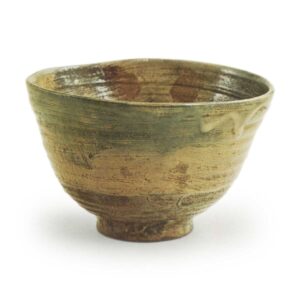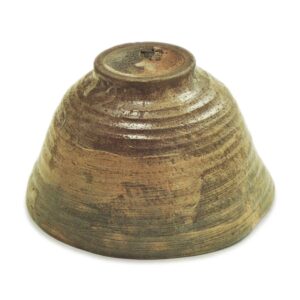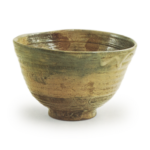

Height: 8.0cm
Diameter: 12.2-13.2cm
Foot diameter: 5.0cm
Height: 0.7cm
The name “Roun” is thought to have been given in reference to the glaze and glaze color of the tea bowl.
As is commonly believed, Asahiyaki was added to the list of the seven Enshu kilns, and it is thought that the kiln smoke was popular in the early Edo period, but there are many things about its history that are unclear. However, according to the “Kakuzuki-ki” (Record of the Separation of the Two Worlds) by the priest Hourin of Kinkakuji Temple, it is thought that from the Kan’ei era to the Shouho era, copies of the Gohonte tea bowls were made by the potters of Yasaka and Awata in Kyoto , and it is thought that Asahiyaki, which is said to be one of the seven Enshu kilns, may have been a tea bowl kiln that imitated such Gohonte tea bowls. However, it is not clear whether the “dohimo chawan” and “ro-nami” were made during the so-called Enshu period, which spanned the years from Kan’ei to Shoho, or whether they were made at a later date, and so we must leave this for further study in the future.
This tea bowl is quite thin overall, and although it is a work of considerable artistry, it is thought to be an Asahiyaki from the early Edo period based on its workmanship.
The foot ring is simply cut out, but from the foot ring, which is cut round, to the rim, it rises in a roughly ten-step spiral, with the lathe marks clearly visible, and there are two dents in the thin rim, which were made intentionally to hold the tea spoon. The workmanship is similar to that of the Gohon Hakeme ware from the Busan kiln.
The inside and outside of the bowl are brushed with a thin layer of glaze, and then covered with a transparent ash glaze. However, a white glaze appears on the outside of the rim, and the color gradually changes to a reddish hue from the waist down, creating a deep and rich appearance. The interior glaze is tinged with a bluish-gray color, and the brush marks are also visible, but the brush marks on the inside are even more vivid. The foot ring, which shows the grayish-brown clay surface containing iron, is also covered with a bluish glaze in some places, and the two characters “Asahi” (meaning “morning sun”) are stamped on the left side.
The overall appearance of the brush marks is truly befitting of the name “Roun”, and despite its thin and elegant construction, it also has a dignified feel to it, and together with the “dohimo” (waistband), it is no surprise that it has long been highly regarded as a thin brown tea bowl that stands out among the national wares.
The author of the gold-powder lettering on the lid of the red lacquered inner box, which reads “Asahi Chawan Rounami”, is unknown. The gold-painted calligraphy on the lid of the black-lacquered outer box, “Asahi Chawan Rounami”, and the gold-painted calligraphy on the reverse of the lid, “Omiya (signature)”, are the work of Saigyoan Shimomura Jitsuri, a tea master of the Kuda school who taught tea to Morikawa Jochuan, the former owner of the tea bowl.
The origin of the tea bowl in the olden days is completely unknown, but it was owned by Toda Rogen of Osaka in the Meiji era, who was proud of it as a masterpiece of the Asahi tea bowl. Along with the “Dohimo teacup”, it is also listed in the “Taisho Meiki Kan” as a reflection of the Asahi teacup, and is a famous teacup that is much talked about among tea ceremony enthusiasts.








